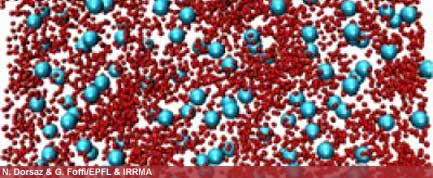The Physics of Fading Eyesight Revealed

A molecular dance of sorts between two proteins in the eye lens can create either perfect vision or cloudy cataracts.
By applying physics and biology to the complexities of vision, scientists discovered even a slight change in the interaction between proteins that make up the lens of the eye can lead to a protein clumping and in turn cataract formation, the world's leading cause of blindness.
A new set of images reveals how things can go wrong.
There is currently no known way to reverse the "protein aggregation" process once it has begun. Every year, nearly 5 million people undergo cataract surgery, which involves replacement of the cloudy lenses with artificial ones.
This work could shed light on other protein aggregation diseases (such as Alzheimer’s disease) and may one day lead to methods for stabilizing protein interactions and thus preventing cataracts and other similar diseases.
The eye lens is made up of densely packed crystallin proteins whose arrangement is such that the lens is transparent to visible light. For various reasons, including exposure to ultraviolet light and age-related factors, the proteins "misbehave" and clump together. Instead of passing through the now-compromised lens, light gets scattered. The result is cloudy vision or blindness.
Previous research has shown that the interactions between the three major crystallin proteins that make up the eye lens are key to cataract formation.
Sign up for the Live Science daily newsletter now
Get the world’s most fascinating discoveries delivered straight to your inbox.
Anna Stradner of the University of Fribourg in Switzerland and her colleagues studied the interactions of two of these proteins using both lab experiments and computer simulations.
They modeled the proteins as spheres with varying levels of attraction and repulsion, from no mutual attraction in which the two proteins just separated to very strong attraction in which the protein spheres clumped together. When the attraction forces were just right, the spheres stayed uniformly mixed—clear vision.
“By combining experiments and simulations it became possible to quantify that there had to be a weak attraction between the proteins in order for the eye lens to be transparent,” said study researcher Giuseppe Foffi of the Institute for Numerical Research in the Physics of Materials in Switzerland. “Our results indicate that cataracts may form if this balance of attractions is disrupted, and this opens a new direction for research into cataract formation.”
The results, reported in the Nov. 9 issue of the journal Physical Review Letters, suggest in the future these properties could be tweaked to prevent clumping or even reverse the clumping process once it has begun.
- Scientists Envision Growing Human Eyeballs
- Video: Implant Helps Blind Cats See
- Top 10 Mysterious Diseases











